Fatima Masumeh Shrine
The Shrine of Fatima Masumeh (Persian: حرم فاطمه معصومه translit. haram-e fateme-ye masumeh) is located in Qom, which is considered by Twelver Shia Muslims to be the second most sacred city in Iran after Mashhad.
| Fatima Masumeh Shrine | |
|---|---|
_(cropped).jpg.webp) A March 2018 aerial photograph of Fatima Masumeh Shrine with golden dome and Azam Mosque of Qom | |
| Religion | |
| Affiliation | Twelver Shi'ite Islam |
| Location | |
| Location | Qom, Iran |
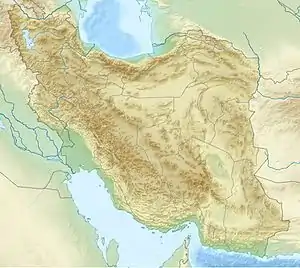 Shown within Iran 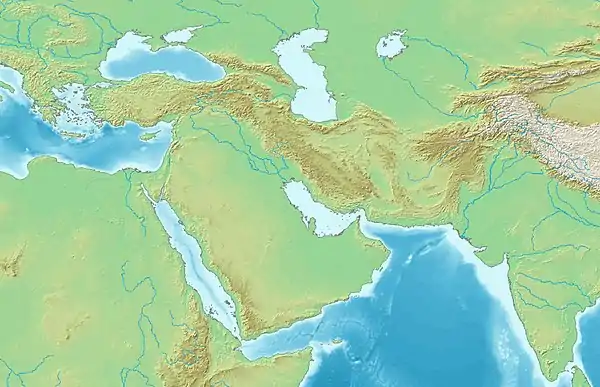 Fatima Masumeh Shrine (West and Central Asia) | |
| Geographic coordinates | 34.6417°N 50.8790°E |
| Architecture | |
| Type | Mosque |
| Style | Iranian |
| Specifications | |
| Dome(s) | 3 |
| Minaret(s) | 6 |
Fatima Masumeh was the sister of the eighth Twelver Shi'ite Imam Reza, and the daughter of the seventh Imam Musa al-Kadhim (Tabari 60). In Shia Islam, women are often revered as saints if they are close relatives to one of the Twelver Imams. Fatima Masumeh is therefore honored as a saint, and her shrine in Qom is considered one of the most significant Shi'i shrines in Iran. Every year, thousands of Shi'i Muslims travel to Qom to honor Fatima Masumeh and ask her to ask God for blessings. Also buried within the shrine are three daughters of the ninth Twelver Imām Muhammad al-Taqī.[1]
Specifications
The mosque consists of a burial chamber, three courtyards and three large prayer halls, totalling an area of 38,000 m2 (410,000 sq ft). The three prayer halls are named: Tabātabā'ī, Bālā Sar, and A‘dham.[2][3]
Ziyarah
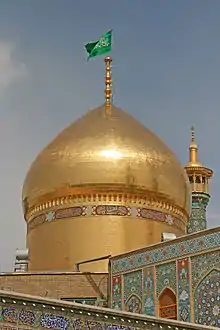
Though Shi'i theology formally states that the relatives of the Imams, or Imamzadehs, hold a lower status than the Imams, popular Shi'ism still strongly venerates imamzadehs.[4] In Iran, there are many more burial places of the Imams' relatives than there are for the Imams themselves.[4] Imamzadehs are considered to be close to God and religiously pious because of their close relation to Imams.[5] Shi'is commonly travel on pilgrimages to shrines of imamzadehs, such as the Shrine of Fatima Masumeh, the sister of the 8th Imam 'Ali al-Rida, in Qom, Iran. Men and women seek cures to ailments, solutions to problems, and forgiveness of sins at these sites.[5] Many hadiths, or teachings, are recorded from Shi'i Imams praising the veneration of Fatima Masumeh, and proclaiming that those who make a pilgrimage to her Shrine will "certainly be admitted to heaven."[2]
Fatima Masumeh's Shrine in Qom is crowded every day of the year with Shi'i men, women, and children from all around the world. Some stay for hours or days praying at the mosque and circumambulating her tomb. The economy of Qom has become reliant on this pilgrimage for the tourism it brings.[6] In turn, Qom has remained conservative and traditional to maintain a pious environment for pilgrims.[7] Many miracles have been recorded as taking place at this shrine, and they are documented in a special office within the shrine complex. Some are published in the shrines monthly newspaper, the Payam-e Astan.[2]
Pilgrims at the Shrine of Fatima Masumeh follow rituals that have been passed down for centuries. Imam Ali al-Rida, Fatimah's brother, outlined these ritual acts as he described the way he visited her Shrine. The prayer Imam al-Rida dictated to his sister continues to be part of the pilgrimage.[4] Since the Safavid period, additional rituals have been added that are now typical for many Shi'i pilgrimages including ritual washing beforehand, dressing in perfumed clothing, and entering the site with one's right foot.[4]
History
Early
Since the beginning of Qom's history in the 7th century, the city has been associated with Shi'ism and set apart from the Sunni caliphate.[4] Many Shi'i hadiths referred to Qom as a "place of refuge for believers," calling it a deeply religious place. After Fatima Masumeh's death in Qom and the construction of her Shrine, scholars began to gather in Qom and the city gained its reputation for religious learning. Today, Qom is still noted for its religious seminaries and organizations.[2]
Fatima Masumeh died in Qom in 816 (201 AH) as she travelled to join her brother, Imam Ali al-Rida in Khorasan.[2] The caravan she travelled in was attacked in Saveh by the Abbasid Sunnis, and 23 of Fatima Masumeh's family and friends were killed (Jaffer). Fatima Masumeh was then poisoned by a woman from the Sunni enemies, fell ill, and asked to be taken to Qom, where she died.[2] Fatima Masumeh's host in Qom buried her in his plot of land.[4]
The style of Fatima Masumeh's Shrine has developed over many centuries.[8] At first, her tomb was covered with a bamboo canopy.[4] Fifty years later, this was replaced by a more durable domed building, at the request of the daughter of Imam Muhammad at-Taqī, Sayyida Zaynab.[4][2] The family of Sayyida Zainab later added a further two domes to the Shrine.[4] These architectural projects marked the beginning of female patronage of the tomb of Fatima Masumeh.
Safavid period

In 1519, Tajlu Khanum, the wife of Shah Isma'il I, led a project to improve the drainage around the Shrine, embellish the Shrine with an iwan and two minarets, and reconstruct the tomb chamber as a domed octagon. During the Safavid dynasty, the women of this family were very active in embellishing the Shrine of Fatima Masumeh. In times of war, Safavid royal women found refuge in Qom, and likely compared their situation to that of Fatima Masumeh. These women donated beautiful fabrics and other items to the Shrine. Shah Abbas I of the Safavids did not patronize the Shrine of Fatima Masumeh as much as he did other shrines of Imams, but he did offer books to the Shrine's seminary library.[4] Over the years, many Safavids of royal birth were buried close to the Shrine of Fatima Masumeh.
Modern

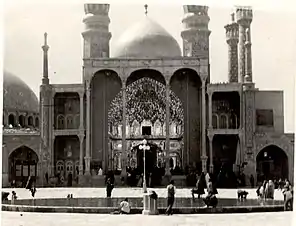
From 1795–1796, Fath-Ali Shah Qajar converted two Safavid sahn or courtyards into one large courtyard and, in 1803, fixed the golden dome. In 1883, Amin al-Sultan added the new sahn e-jadid or "New Court" to the Shrine complex.[8]
.jpg.webp)
During Ayatollah Khomeini's 1979 Iranian Revolution, Qom was named "the birthplace" of this movement. Khomeini studied in Qom and lived there at the beginning and end of the Revolution. Aspects of the culture of Qom, including the Shrine of Fatima Masumeh, were used to unite the Iranian people over significant historical and mythical events.[9] Khomeini used images of the Shrine of Fatima Masumeh in posters, money, and stamps created during the Revolution.[8] Khomeini also constructed an addition to the Shrine of Fatima Masumeh and added more space for pilgrims.[2] In addition, the tomb of Ayatollah Khomeini utilizes architectural elements that are similar to Fatima Masumeh's Shrine, such as the golden dome.[8] See Mausoleum of Khomeini.
Notable burials
- Fatemeh Masumeh (790–816) – daughter of Musa al-Kadhim
Royalty
- Kheyr al-Nesa Begum (1548–1579) – Safavid princess
- Shah Safi (1611–1642) – Shahanshah of Persia (1629–42)
- Shah Abbas II (1632–1666) – Shahanshah of Persia (1642–66)
- Shah Suleiman I (1647–1694) – Shahanshah of Persia (1666–94)
- Shah Sultan Hossein (1668–1726) – Shahanshah of Persia (1694–1722)
- Shah Abbas III (d. 1739) – Shahanshah of Persia (1732–36)
- Qahraman Mirza (fa) (d. 1840) – Qajar prince
- Fath-Ali Shah (1772–1834) – Shahanshah of Persia (1797–1834)
- Mohammad Shah (1808–1848) – Shahanshah of Persia (1834–48)
- Galin Khanom (fa) (d. 1857) – Qajar princess
- Malek Jahan Khanom Mahd-e Olia (1805–1873) – mother of Nasser al-Din Shah Qajar
- Fakhr od-Dowleh (it) (1861–1893) – Qajar princess
- Afsar od-Dowleh (fa) (1859–1901) – Qajar princess
- Ali-Naghi Mirza (fa) (1860–1917) – Qajar prince
- Malek-Mansour Mirza (1880–1922) – Qajar prince
- Abdolsamad Mirza (fa) (1845–1929) – Qajar prince
- Kamran Mirza (1856–1929) – Qajar prince and governor of Tehran
Political figures
- Hassan Khan Mostowfi ol-Mamalek Ashtiani (fa) (1781–1845) – politician
- Manouchehr Khan Gorji Mo'tamed od-Dowleh (d. 1847) – politician
- Ali Khan Hajeb od-Dowleh (fa) (d. 1867) – politician
- Anoushirvan Khan Etezad od-Dowleh (d. 1868) – politician
- Farrokh Khan Amin od-Dowleh (1812–1871) – Persian ambassador to France and Great Britain
- Asadollah Nazem od-Dowleh (fa) (d. 1900) – politician
- Ali-Asghar Khan Amin os-Sultan (1843–1907) – prime minister (1887–96) and (1907)
- Mohammad-Baqer Khan Saad os-Saltaneh (d. 1907) – politician
- Ebrahim Motamed os-Saltaneh (fa) (d. 1917) – politician
- Ahmad Khan Moshir os-Saltaneh (1844–1919) – prime minister (1907–08)
- Mohammad Eqbal od-Dowleh (fa) (1848–1924) – politician
- Yahya Diba Nazem od-Dowleh (fa) (1886–1940) – politician
- Hassan Vosough Vosough od-Dowleh (1873–1950) – prime minister (1909–10, 1911 and 1916–17)
- Abdollah Vosough Motamed os-Saltaneh (fa) (1884–1952) – politician
- Ahmad Qavam Qavam os-Saltaneh (1876–1955) – prime minister (1921, 1922–23, 1942–43, 1946–47 and 1952)
- Faramarz Asadi (1869–1969) – politician
- Hossein Dadgar Adl ol-Molk (1881–1971) – speaker of the Majles (1928–35)
- Mohammad-Vali Gharani (1913–1979) – army general
- Mehdi Eraqi (1930–1979) – a founder of Fadayan-e Islam
- Mehdi Bazargan (1907–1995) – prime minister (1979)
Scholars
- Aghabeyim Javanshir (1780–1832) – poet
- Yusef Etesami Ashtiani (1874–1938) – writer and translator
- Parvin Etesami (1907–1941) – poet
- Mohammad Meshkat (fa) (1900–1980) – scholar
- Ali Davani (1929–2007) – author
Clerics
- Qotbeddin Ravandi (fa) (d. 1177) – medieval cleric
- Fazlollah Nouri (1843–1909) – cleric
- Abdolkarim Haeri Yazdi (1859–1937) – cleric
- Mehdi Ashtiani (1888–1952) – cleric
- Mohammad-Taghi Khansari (fa) (1888–1952) – cleric
- Sadreddin Sadr (1882–1954) – cleric
- Hossein Borujerdi (1875–1961) – cleric
- Soltan ol-Vaezin Shirazi (1894–1971) – cleric
- Morteza Motahhari (1920–1979) – cleric
- Mohammad Mofatteh (1928–1979) – cleric
- Mohammad-Hossein Tabatabaei (1904–1981) – cleric
- Asadollah Madani (1914–1981) – cleric
- Ali Qoddusi (1927–1981) – cleric
- Mohammad Montazeri (1944–1981) – cleric
- Khalil Kamarei (1898–1984) – cleric
- Reza Zanjani (1902–1984) – cleric
- Ahmad Khonsari (1887–1985) – cleric
- Morteza Haeri Yazdi (1916–1986) – cleric
- Shahabeddin Marashi Najafi (1897–1990) – cleric
- Mohammad-Reza Golpaygani (1898–1993) – cleric
- Hashem Amoli (1899–1993) – cleric
- Mohammad-Ali Araki (1894–1994) – cleric
- Mohammad-Jafar Moravej (1902–1999) – cleric
- Ahmad Azari Qomi (1925–1999) – cleric
- Mohammad Shirazi (1928–2001) – cleric
- Esmail Mousavi Zanjani (1928–2002) – cleric
- Sadegh Khalkhali (1926–2003) – cleric ("Eichmann of Iran")
- Mohammad Vaez Abaee Khorasani (1940–2004) – cleric
- Javad Tabrizi (1926-2006) – cleric
- Ali Meshkini (1921–2007) – cleric and chairman of Assembly of Experts (1983–2007)
- Mohammad Fazel Lankarani (1931-2007) – cleric
- Ahmad Mojtahedi Tehrani (1923-2008) – cleric
- Mohammad-Taqi Behjat Fumani (1913–2009) – cleric
- Hossein-Ali Montazeri (1922–2009) – cleric
- Mohammad Mofti al-Shia Mousavi (1928–2010) – cleric
- Abbas Hosseini Kashani (1931–2010) – cleric
- Mohammad-Hassan Ahmadi Faqih (1951–2010) – cleric
- Yousef Madani Tabrizi (1928–2013) – cleric
- Moslem Malakouti (1924–2014) – cleric
- Abdol-Karim Mousavi Ardabili (1926–2016) – cleric and chief justice (1981–89)
- Ahmad Ahmadi (1933–2018) – cleric
- Mahmoud Hashemi Shahroudi (1948–2018) – cleric and chief justice (1999–2009)
- Nasrallah Shah-Abadi (1930-2018) – cleric
- Mohammad Hossaini Shahroudi (1925–2019) – cleric
- Qorban-Ali Mohaqeq Kaboli (1927–2019) – cleric
- Mohammad Momen (1938–2019) – cleric
- Ebrahim Amini (1925–2020) – cleric
- Mohammad Yazdi (1931–2020) - cleric and chief justice (1989–1999)
- Mohammad-Taqi Mesbah-Yazdi (1935–2021) - cleric
See also
References
- "Qum, Iran". sacredsites.com. Retrieved 12 March 2009.
- Jaffer, Masuma (2003). Lady Fatima Masuma (a) of Qum. Qum: Jami'at al-Zahra. ISBN 964-438-455-5.
- "Today's Top StoriesQom Province". indiasnews.com. Archived from the original on 20 December 2008. Retrieved 18 December 2006.
Shrine of Hazrat Masoumeh, sister of Imam Reza, one of Iran's holiest places, is in Qom.
- Canby, Sheila R. (2009). Shah 'Abbas: The Remaking of Iran. London: The British Museum Press.
- Betteridge, Anne H. (2002). "Muslim Women and Shrines in Shiraz". In Donna Lee Bowen and Evelyn A. Early (ed.). Everyday Life in the Muslim Middle East (2 ed.). Bloomington: Indiana University Press. pp. 276–289.
- Majd, Hooman (2008). The Ayyatolah Begs to Differ: The Paradox of Modern Iran. New York: First Anchor Books.
- Khosrokhavar, Farhad (2011). "Post-revolutionary Iranian youth: The case of Qom and the new culture of ambivalence". In Roksana Bahramitash and Eric Hooglund (ed.). Gender in Contemporary Iran: Pushing the boundaries. London: Routledge. pp. 99–119.
- Allan, James W. (2012). The Art and Architecture of Twelver Shi'ism: Iraq, Iran, and the Indian Sub-Continent. Oxford: Azimuth Editions.
- Rivzi, Kishwar (2003). "Religious Icon and National Symbol: The Tomb of Ayatollah Khomeini in Iran". Muqarnas. 20: 209–224. doi:10.1163/22118993-90000045.
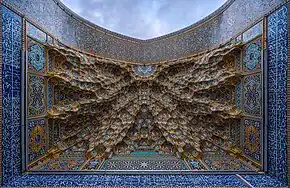







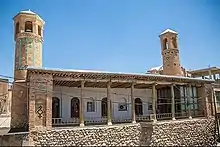
%252C_2014.JPG.webp)







